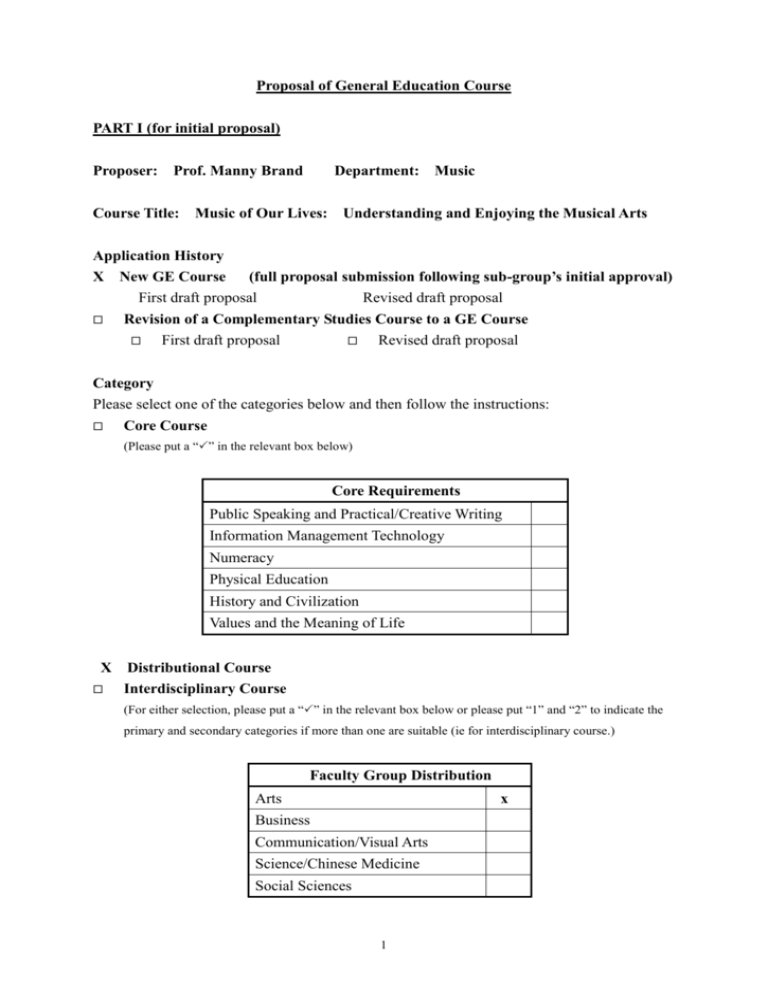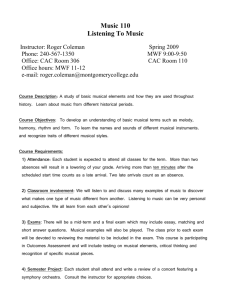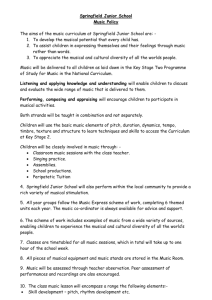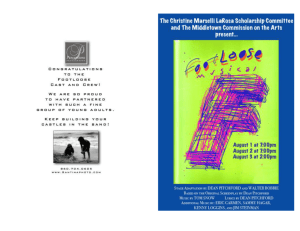Draft Proforma
advertisement

Proposal of General Education Course PART I (for initial proposal) Proposer: Prof. Manny Brand Course Title: Department: Music Music of Our Lives: Understanding and Enjoying the Musical Arts Application History X New GE Course (full proposal submission following sub-group’s initial approval) First draft proposal Revised draft proposal Revision of a Complementary Studies Course to a GE Course First draft proposal Revised draft proposal Category Please select one of the categories below and then follow the instructions: Core Course (Please put a “” in the relevant box below) Core Requirements Public Speaking and Practical/Creative Writing Information Management Technology Numeracy Physical Education History and Civilization Values and the Meaning of Life X Distributional Course Interdisciplinary Course (For either selection, please put a “” in the relevant box below or please put “1” and “2” to indicate the primary and secondary categories if more than one are suitable (ie for interdisciplinary course.) Faculty Group Distribution Arts x Business Communication/Visual Arts Science/Chinese Medicine Social Sciences 1 Number of Units: 3 Contact Hours: 3 hours per week Course Co-ordinator(s) /Teacher(s) (Name) Manny Brand (Dept) Music (Name (Dept) (Name) (Dept) (Name) (Dept) Course Aims (no more than 150 words): This purpose of the course is three-fold. First, there is a fundamental focus on students becoming educated and active music listeners of Western and Asian music representative of a wide range of music literature primarily from 1850 to the present. Second, the course will emphasize the development of an understanding of musical characteristics and artistic elements reflective of music of Hong Kong, China, Europe, and Americas. Third, students will gain insights into the place and role of music in not only diverse cultural and historical contexts, but also examine how the students themselves use music in their lives. Learning Outcomes: Upon successful completion of this course, students should be able to: No. Learning Outcomes (LOs) 1 Demonstrate knowledge of the diversity of musical ideas and values embodied in the music listening experience with specific focus on music of Hong Kong, China, Europe, and Americas from 1850 to the present. 2 Identify and explain basic concepts of music reflective of a wide range of musical times, styles, and cultures including knowledge of the elements of music (e.g., melody, harmony, form), universality of music, human need for music, and functions of music in society. 3 Demonstrate creative and aesthetic understanding of the various elements of music such as sound, pitch, dynamics, tone color, harmony, and rhythm. 4 Identify and explain the role and function of music in diverse cultural and historical settings with specific reference to music and aesthetics, culture, and media. 5 Examine the role and function of music in the students’ individual lives to include music and clubs, parties, consumerism, and emotions. 2 Maximum number of students per session: 160 Maximum number of sessions the teacher is prepared to offer: 1 per semester Is the course ready for Pilot-test before 2012? No X Yes, please indicate when it can be offered ○ Sem 1 2009/10 ○ Sem 1 2010/11 X Sem 1 2011/12 3 ○ Sem 2 2009/10 ○ Sem 2 2010/11 X Sem 2 2011/12 PART II (for detailed proposal only) Alignment with Overall Intended Learning Outcomes of the GE Programme (PLO): Learning Outcomes Please indicate alignment by ticking the appropriate box PLO1 PLO2 PLO3 PLO4 PLO5 PLO6 PLO7 LO1 X X LO2 X X LO3 X X LO4 X X X LO5 X X X Alignment with Intended Learning Outcomes of the GE Category (CLO): Learning Outcomes Please indicate alignment by ticking the appropriate box CLO1 CLO2 CLO3 CLO4 LO1 X X X X LO2 X X X X LO3 X X X X LO4 X X X X LO5 X X X X CLO5 Constructive Alignment of Teaching and Learning Activities with Learning Outcomes: Teaching No. Teaching and Learning Activities LO No. hours 1 Guided music listening practice, lecture, discussion 1 7 2 3 4 5 Presentations and in-class live performances Lecture, discussion following in-class live performances Lecture and discussions based on guided music listening practice. Presentations, small group discussions, musical examples 4 2 7 3 8 4 8 5 8 Assessment: No. Assessment Methods/Activities 1. Test 1 (including analysis of musical Examples) Test 2 (including analysis of musical Examples) 20 % Test 3 (including analysis of musical Examples) Test 4 (including analysis of musical Examples) 20% Essay – following attendance at assigned 15% 2. 3. 4. 5. Weighting Remarks 20% 25% musical performances Course Content in Outline: Topics Teaching Hours Universality of music (evidence of prehistoric music-making, why do humans need music, functions of music in society) 10% Elements of music (sound, pitch, dynamic, tone color, harmony, rhythm) 25% Music and the emotions 10% Music and the political 5% Music and clubs, parties, consumerism 5% Music and film 5% Music and visual arts 5% Guided music listening (selected from music from Hong Kong, Africa, China, Indonesia, Islam, India, Europe, and Americas) 35% References: 1. Aubert, L. (2007). The music of The other. Hampshire, UK: Ashgate. 2. Titon, J. T. (2002). Worlds of music: An introduction to the music of the world’s people. New York: Schirmer/Thomson Learning Publisher. 3. Barnes, S. H. (1988). Muzak-the hidden messages in music: A social psychology of culture. New York: E. Mellen Press. 4. Jackaway, G. (1999/2000). Selling Mozart to the masses: Crossover marketing as cultural diplomacy. Journal of Popular Music Studies 11 & 12, 5 5. 6. 7. 8. 125-150. Reynolds, S. (1998). Generation Ecstasy: Into the World of Techno and Rave Culture. London: Little, Brown. Small, C. (1998). Musicking: The meanings of performing and listening. Middletown, CT: Wesleyan University Press. Thornton, S. (1996). Club Cultures: Music, media, and subcultural capital. Middletown, CT: Wesleyan University Press. Walser, R. (1993). Running with the devil: Power, gender, and madness in heavy metal music. Middletown, CT: Wesleyan University Press. PART III (for both initial and detailed proposal) Endorsement and Resources Commitment Endorsement of and confirmation of resources commitment to teaching the proposed GE course by all Heads and Deans concerned. Head, Department/Programme/Centre of Signature: Date: Head, Department/Programme/Centre of Signature: Date: Head, Department/Programme/Centre of Signature: Date: Dean, Faculty/School/Academy of Signature: Date: Dean, Faculty/School/Academy of Signature: Date: 6







